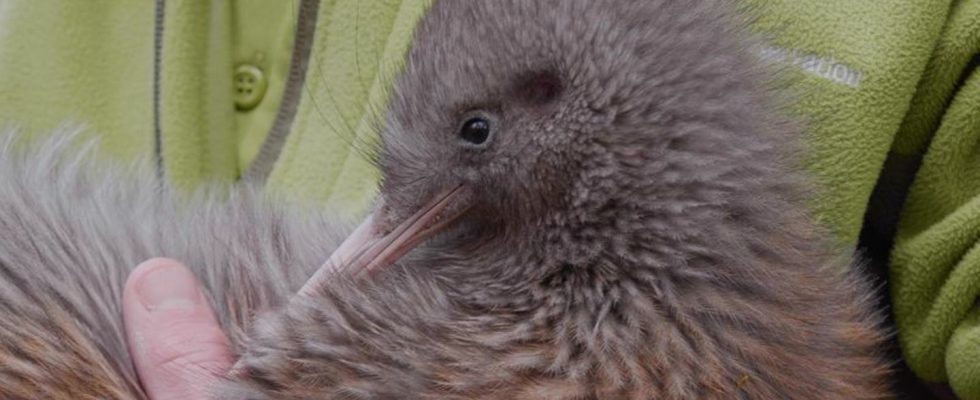Most people think of fruit when they hear the word kiwi. In New Zealand, however, the kiwi is also a bird. He enjoys great popularity and has become a curious namesake.
The kiwi is truly a strange bird. He can’t fly, has pretty bad eyesight and his nostrils are chronically blocked. Also, it smells musty.
Despite or perhaps because of its many peculiarities, the New Zealanders have taken the oddball into their hearts like no other creature – and celebrate it as the national bird, which adorns one dollar coins, logos and books, among other things. Kiwis (scientific: Apteryx) are the smallest ratites in the world and are only found in New Zealand. According to the nature conservation authority, they are one of the most important figureheads of the unique wildlife of the Pacific state.
The kiwi and the kiwi fruit
The indigenous people in particular have a strong cultural and spiritual connection to the nocturnal bird. The Maori use its fluffy feathers to weave the “kahu kiwi” (kiwi feather cloak) for high-ranking figures. But the bird is the favorite of the whole people, who have named themselves after him: Kiwi, the word has long been synonymous with the New Zealanders.
The national rugby team is nicknamed the “Kiwis”, there is a Kiwibank and the state pension fund is called the KiwiSaver. What many do not know: even the kiwi fruit is named after the feathered animal. Because at the beginning of the 20th century, the fruit variety was cultivated in New Zealand for the first time outside of Asia.
Originally known as the “Chinese gooseberry,” the fruit was first marketed by an export company in 1959 as the kiwi – a name that has caught on around the world. The traders had probably identified similarities: “The fruit and the bird have a lot in common – both are small, brown and furry,” writes the market leader Zespri Kiwifruit on its website.
endangered species
There are five types of snipe ostrich, as the birds are also called. But the national icon is in danger. The Department of Conservation estimates the number to be fewer than 70,000 and warns: “We lose 2 percent of our unprotected kiwis every year – that’s about 20 a week.” For comparison: Before people settled in New Zealand, according to research, twelve million kiwis populated the island state.
Above all, the loss of habitat due to large-scale clearing and introduced predators such as cats and martens are causing problems for the birds. According to plans by the authority, their number should rise again to at least 100,000 by 2030.
The organization Save the Kiwi helps: Employees collect eggs in the wild to hatch them safely. The young kiwis are initially raised in captivity and then released to predator-free sites. New protected areas are an important part of the project.
Good to know
Kiwis are “incredibly unique creatures” with traits more akin to mammals, says organization executive director Michelle Impey. “The kiwi is the only bird with external nostrils at the end of its long beak.” But that also has disadvantages: “Kiwis can often be heard sniffling and snorting loudly to remove dirt from their nostrils.”
When searching for food, the bird repeatedly hits the ground with its beak to absorb vibrations from prey underground, “almost like a walking stick,” says the expert. Although he can’t see very well, the parts of his brain that are responsible for smelling and touching are downright huge.
The peculiarities go even further: The muscular legs of the kiwi are very heavy and – like in mammals – filled with bone marrow. Most other birds have lightweight skeletons that favor flight. “The feathers are shaggy and hairy, and the kiwi has cat-like whiskers on its face—all very different from regular birds,” says Impey.
When he calls, it sounds like a pig grunting. Its eggs are huge, and when a chick hatches, it turns out to be a fully feathered bird capable of feeding itself. All of this makes the Kiwi an outsider – just as many New Zealanders see themselves on their island at the end of the world.
Much need for protection
The illustrator Kat Quin has turned the curious animals into the heroes of a whole series of children’s books: Kuwi the kiwi. The protagonist is a mother animal who has to take care of her offspring alone. Quin donates part of the sales proceeds to Save the Kiwi. 60,000 New Zealand dollars (34,000 euros) have already been raised.
During her research, the author got very close to the animals, which only a few manage to do. “I was surprised how much they stink,” says Quin. “They smell really musty. That makes them a target for predators who can track them down easily.”
And there’s another danger: kiwis don’t have strong bones in their thorax like birds that can fly. Even a gentle nudge from an inquisitive dog can cause internal injury or even death.
That’s why there was an outraged reaction in New Zealand when it was announced that the Miami Zoo was offering up-close encounters with a kiwi named Paora. Visitors were allowed to pet the animal in bright light and take selfies with it for a fee – very uncomfortable for a nocturnal bird.
Angry New Zealanders started an online petition entitled “Save this abused Kiwi”. It said: “He’s been tamed and exposed to bright neon lights four days a week, being touched by dozens of strangers, his delicate whiskers stroked, laughed at and displayed like a toy.” Kiwis are “precious treasures, not America’s toys”. The zoo apologized and removed the kiwi encounters.

